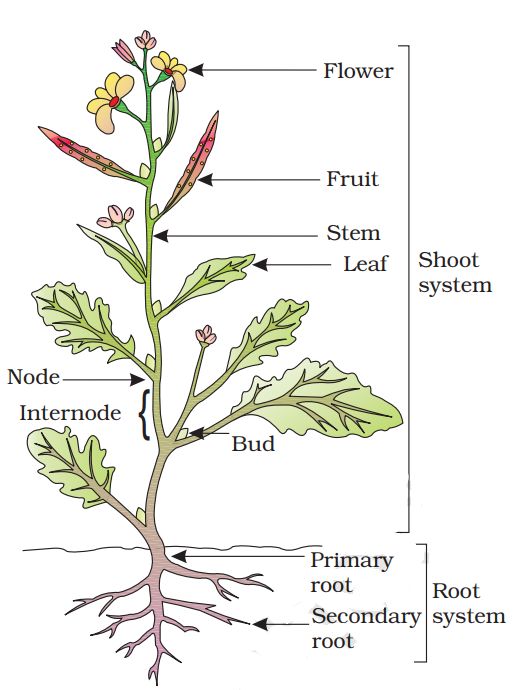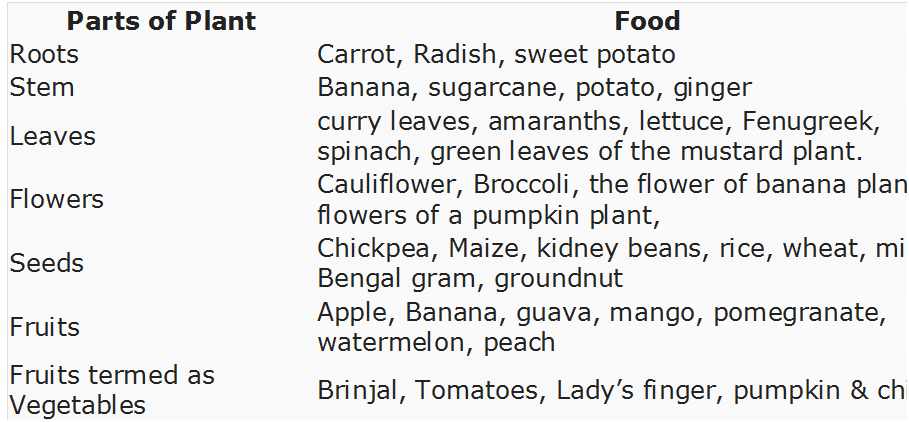Plants are usually grouped into herbs, shrubs, trees, and climbers based on their height, stems and branches.
- Herbs are small plant which have soft stem.
- Shrubs are bushy and medium sized plants and they are somewhat bigger than herbs. Their branches start from just above the ground.
- Trees are tall and large plants with hard and woody stem.
- Plants with weak stem that cannot stand upright and spread on the ground are called creepers.
- Books Name
- CBSE Class 6 Science Book
- Publication
- Param Publication
- Course
- CBSE Class 6
- Subject
- Science
Source of food
There are two main sources of food in the world for all human beings – namely plants and animals.
* Plants as Source of Food : Foods obtained from plants are of different types — cereals, pulses, vegetables, fruits, oils, sugar, tea, coffee and spices.
(i) Cereals are the most important sources of food for man and animals. They are rich sources of carbohydrates. Three most important cereals are wheat, rice and maize. These cereals are obtained from grains (biologically, grains are fruits of a plant).
(ii) Pulses or Legumes (commonly called 'dals') are rich in proteins and are obtained from plants.
(iii) Vegetables are rich sources of vitamins, minerals and roughage.Water content in vegetables is high (70 to 90 per cent) and their food value is low.
(iv) Fruits have high water content, low food value, but are rich in minerals and vitamins. In common usage, the term 'fruit' is used for those which are usually eaten without cooking.
Common fruits are banana, mango apple, grapes, pineapple, guava, orange, litchi, and so on.
(v) Sugars are produced by the green plants through photosynthesis. Chief sugar producing plants are sugarcane and sugarbeet.
In case of sugarcane, the plant part used is the stem, while in sugarbeet, it is the root.
(vi) Tea and coffee are common beverages, Tea is obtained from leaves, while coffee is obtained from seeds.
(vii) Spices have no food value and are used for adding flavour to food. Before the advent of refrigeration, spices were also used for preserving foods.
The important spices are pepper (kali mirch), cardamon (ilaichi), ginger (adrak), turmeric (haldi) and chillies (mirch), cloves (loung), saffron (kesar), fennel (saunf), cumin (jeera), coriander (dhania), asafoetida (heeng), fenugreek (methi), nutmeg (jaiphal) and thyme (ajwain).
(viii) Oils : Oils are rich in fat and provide energy. Cotton, groundnut, mustard, coconut, soyabean and sunflower seeds give us oil.
(ix) Medicines : Some plants have medicinal value and are used for curing certain diseases especially in Ayurveda. Mint, Basil (tulsi), ginger, fenugreek (methi), etc. are used in medicines.
- Books Name
- Class 6 Science Book
- Publication
- PathSet Publications
- Course
- CBSE Class 6
- Subject
- Science
Food Materials and Sources
Plant Part As Food
Sources of Food
Let us now learn about food variety and food sources.
- Plants and animals are the two sources of our food materials. So, we obtain food from plants as well as animals.
- Milk, egg, meat, chicken, fish, prawn, beef, pork etc. are the food products that we get from animals.
- Grain, cereals, vegetables and, fruits are the source of food that comes from plants and plants products.
Plant Source
- For us, several parts of the plant serve as sources of food. We eat fruits, vegetables, cereals, and pulses etc, which are types of food that come from various portions of a plant.
- For example, we eat leafy vegetable, fruits, and some parts of plants like stem and roots.
- Green plants -> are called PRODUCERS because they prepare their own food using light, air (carbon dioxide), water, & chlorophyll (green pigment present in trees) by the process of photosynthesis.
- So, we can say that green plants are the primary source of food.

FigurePlant-parts-as-food.png
- Table Given below shows various edible plant parts that serve as food sources for us.

- When the seeds begin to grow (or germinate) by developing tiny roots, they are called Sprouts
- The food value of seeds can be increased by converting them into sprouts
- They are a rich source of vitamins like vitamin A, B & C
- The method of converting seed into sprouts is called Sprouting.

 Izram
Izram
 PathSet Publications
PathSet Publications
